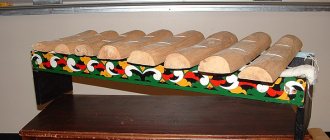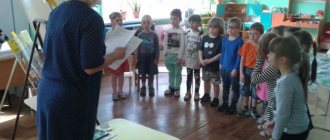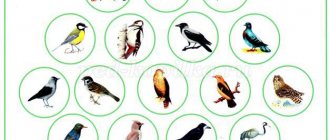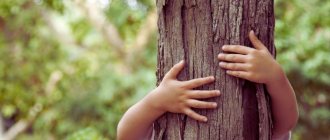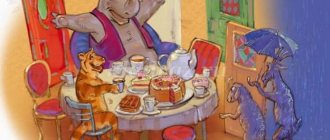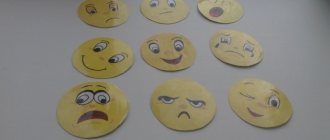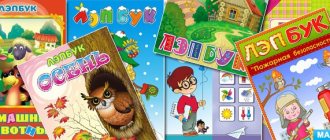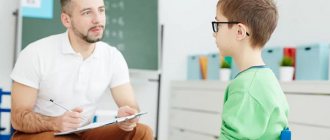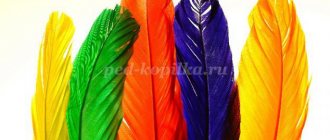Multifunctional teaching aids
Svistunkova Elena
Multifunctional teaching aids
Multifunctional teaching aids.
Educator. Svistunkova E. P.
The benefits that will be discussed can be used in working with children of older preschool age.
Didactic manuals “Uniprism”, “Unicubes”, “Flower - seven-colored”. These benefits can be used in joint activities, in individual work with children, in independent activities.
The purpose of using didactic aids is to increase children's interest in acquiring knowledge about the environment. Develop mental and creative abilities, coherent speech.
The main advantages of the benefits:
- “Uniprism”, “Unicubes”, “Flower - seven-colored” are multifunctional, easy to manufacture, easy to use;
— Develop children’s mental and creative abilities;
- They are a bright element of the subject-development environment.
— Preschoolers can help the teacher in making such aids. Any older preschooler can carefully cut and paste a picture. Children play with such aids with great pleasure, because they are made with their help.
— Thanks to such manuals, you can consolidate previously acquired knowledge in a playful way.
Didactic game “Expedition in the footsteps of literary works. Meeting hardworking heroes."
Target. To form a value-based attitude to communication, moral actions, reflection of value guidelines, and a model of ethical behavior. To consolidate the genre features of a fairy tale, story, poem.
Material. Pictures for folk, foreign, and author's fairy tales, poems, stories.
1st side of the prism - folk tales: “Tops and Roots”, “Turnip”, “Seven Semyons - Seven Workers”, “Winter House”.
2nd side of the prism - author's fairy tales: Odoevsky “Morozko”; S. Ya. Marshak “The Three Little Pigs”, “Twelve Months”; C. Perrault “Cinderella”.
Side 3 - poems: E. Blaginina “Don’t stop me from working”; V. Mayakovsky “Who to be”; M. Smirnova “The Dressmaker”; Y. Tanina “On the Water”; fable by I. A. Krylov “The Dragonfly and the Ant”.
Side 4 – stories: V. Sukhomlinsky “Grandma and Petrik”; “Every person should”; "The Baker and the Tailor"; A. Musatov “How bread came to the table”; V. Oseeva “Sons”.
Multifunctional manual "Unicubes"
The manual consists of a base - a wooden circle, at the base of which there is a rod. There are 2 rotating cubes on the rod. Each side of the cube is a different color. The cubes rotate freely.
This manual may include tasks and exercises in all areas of educational activity: “Cognitive development”, “Speech development”, “Social and communicative development”, “Physical development”, “Artistic and aesthetic development”.
Didactic game “The most, the most.”
Target . Expand children's understanding of different professions. Encourage children to independently determine which professions fit this or that definition. Activate, update, enrich the vocabulary with adjectives. Develop speech and attention.
Material. Cards with images of people, different professions:
- the greenest profession: forester;
- the sweetest profession: beekeeper;
- the reddest profession: firefighter;
- the whitest profession: doctor;
- the bluest profession: astronaut, etc.
Multifunctional manual “Flower - seven-colored”.
The manual consists of 7 petals of different colors and a circle - the middle of the flower.
This manual may include tasks and exercises in all areas of educational activity: “Cognitive development”, “Speech development”, “Social and communicative development”, “Physical development”, “Artistic and aesthetic development”.
Didactic game “Journey through the fairy tales of A. S. Pushkin.”
Target. Activate and enrich the vocabulary on the topic “Tales of A. S. Pushkin.” Develop monologue and dialogic speech. Determine the name of a fairy tale by the beginning (end, tell the fairy tale by the beginning (by the end, by the presented fragment). Cultivate a love for the fairy tales of A. S. Pushkin.
Material. Pictures for fairy tales by A. S. Pushkin.
Multifunctional manual “Magic Circles”.
The manual consists of a base - a wooden square, at the base of which there is a rod. There are 4 rotating circles on the rod. Each circle is divided into sectors of different colors. The circles rotate freely without touching each other.
This manual may include tasks and exercises in all areas of educational activity: “Cognitive development”, “Speech development”, “Social and communicative development”, “Physical development”, “Artistic and aesthetic development”.
Didactic game "Little Housewife"
Target. Expand children's understanding of the variety of food products. Encourage children to independently determine what products are needed to prepare a particular dish. Develop speech and attention.
Material. Food cards:
- cabbage, carrots, peppers, onions - necessary for cooking cabbage soup;
- flour, eggs, butter, milk - necessary to bake pancakes;
- fish, eggs, beets, mayonnaise - “Fish under a fur coat” salad;
- cherry, strawberry, lemon, gooseberry - berry compote.
Didactic manual: “Magic Circles of Lull”
The structure of this manual is very simple:
• Several circles of different diameters are strung on a rod.
• Place an arrow on top.
• All circles are divided into the same number of sectors. Children aged 6-7 years can cope quite well with tasks that use four circles with 8 sectors on each.
• They contain pictures (drawings, words, numbers, objects of the surrounding world).
• The circles and arrow move freely independently of each other. If desired, you can get different combinations of pictures located on sectors and combine seemingly incompatible objects. There are many game options. It all depends on the age, the tasks set, and the material covered by the children.
Main goal: development of logical thinking, oral speech skills, attention, imagination.
Tasks:
-develop cognitive activity;
-sensory development (perception of color, shape);
-form elementary mathematical concepts;
- improve the grammatical structure of speech;
-develop motor skills and hand coordination.
Games using Lull circles can be selected in two directions:
1. To consolidate and clarify existing knowledge;
2. To develop imagination, fantasy and creativity.
The manual can be used in joint and independent activities of children in various educational areas.
Didactic game: “Smart machines.”
Target. To consolidate children’s knowledge that different machines help people in their work; consolidate the ability to correctly name objects; cultivate a respectful attitude towards the work of adults.
Material. Pictures depicting “smart cars”.
Didactic game “Man + nature = amazing things”.
Target. Strengthen the ability to compare objects created by man with objects of nature and find commonality between them (what nature did not give to man, he invented for himself).
Material. Pictures depicting objects of the natural and man-made world.
Didactic game: “Message from the past.”
Target. Strengthen children's ability to name objects and actions related to the past or present. Encourage children to select from the proposed items those that make work easier in agriculture, and explain that these mechanisms and special equipment can: improve quality, increase speed.
Material. Pictures depicting special equipment that makes work easier in agriculture.
Features of use
According to the new generation federal educational standards, which have been introduced into preschool educational institutions, educators must take into account the individual characteristics of each child.
Educational and methodological manuals for preschool educational institutions according to the Federal State Educational Standard have also been developed for children who have serious limitations in physical health.
Continuity
Teaching aids for primary schools are also being developed taking into account the requirements of the new standards. Among the books that can be recommended to primary school teachers, we note the following materials:
- S. A. Kozlova. "I am human. Program for the Social Development of the Child" - Moscow, "School Press", 2003;
- K. Yu. Belaya. “Me and my safety. Thematic Dictionary in Pictures" Moscow, "School Press", 2010;
- V. I. Semenyuk. “Study of traffic rules” - Moscow, “Prosveshcheniye”, 1996;
- R. B. Sterkina. “Fundamentals of safety for primary school age” - Moscow, “Prosveshcheniye”, 2000;
- L. Ya. Kondykinskaya. “Classes on patriotic education in kindergarten” - Moscow, “Sfera”, 2010.
List of benefits, educational programs for the implementation of Federal State Educational Standards (DO)
We offer an approximate list of those materials that meet the requirements of new educational standards introduced into preschool educational institutions related to the physical and psychological education of the younger generation.
- E. Ya. Stepanenkova wrote the manual “Physical Education of Children in Kindergarten”, published by Mosaic-Synthesis in 2006.
- M. A. Runova. The book “Motor Activity in Kindergarten” was published in 2000.
- M. A. Runova. The manual “Acquaintance with nature through movement” was published in 2005.
Of interest are the following teaching materials recommended for use by the Ministry of Education that comply with the new educational standards:
- Manual by M. A. Runova “Physical training equipment for preschool educational institutions” published in 1999.
- A book by L. D. Glazyrina about physical education for preschoolers, published in 2004.
- Material by L.V. Yakovleva on the physical development and health of children aged 3-7 years, which appeared in print in 2003.
- The educational and didactic manual, authored by A.P. Shcherbak, is dedicated to thematic activities and holidays in a preschool institution. It was published in 1999.
- The author T. L. Bogina offers material on health protection in preschool institutions, 2006.
- Material dedicated to raising a healthy child was published by M. D. Makhaneva in 1997.
- A manual that allows you to raise gifted and talented children was created by L. A. Wenger in 2000.
This list includes many more benefits, each of which is aimed at creating a healthy generation that loves its country and respects the traditions of the people.
Principles laid down in the new standards
Among the basic principles that are included in preschool education, we highlight:
- the fullness of the child’s life at all stages of his childhood, the opportunity for development;
- creating educational trajectories based on the individual characteristics of each child;
- full cooperation between children and adults;
- supporting children's creative initiative in a variety of activities.
Educational and methodological aids for preschool educational institutions should help to familiarize preschoolers with social and cultural norms, family values, and pride in their country.
In addition, it is important in preschool age to form a child’s cognitive interest in various types of activities.
Educational and methodological aids for the program from birth to school according to the Federal State Educational Standard take into account the age adequacy of preschool education. All teaching materials must meet the age requirements and developmental characteristics of children.
